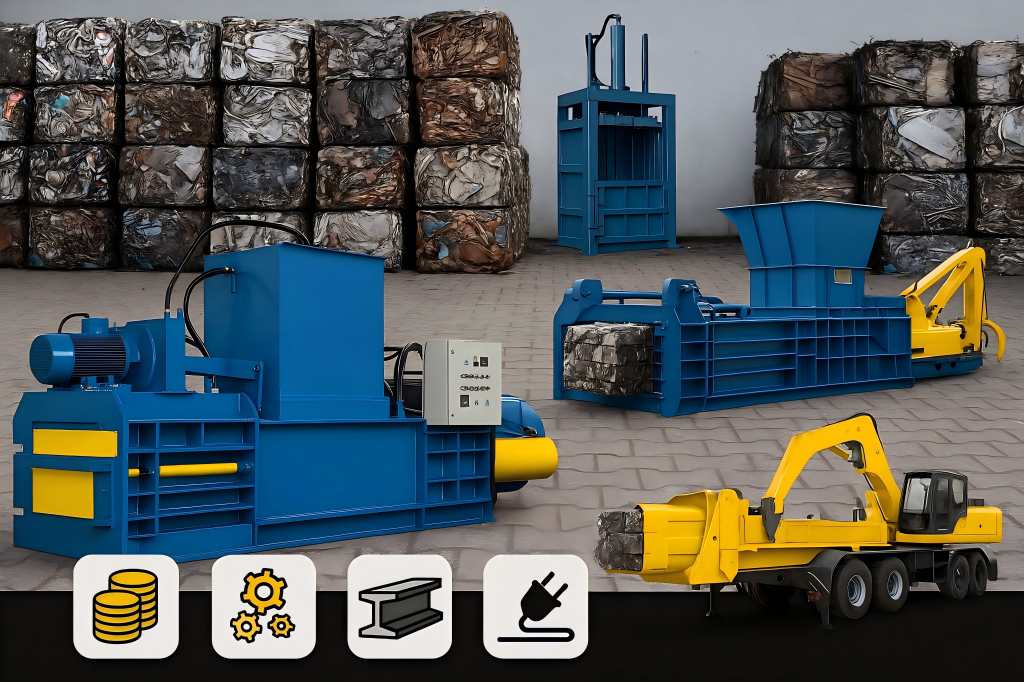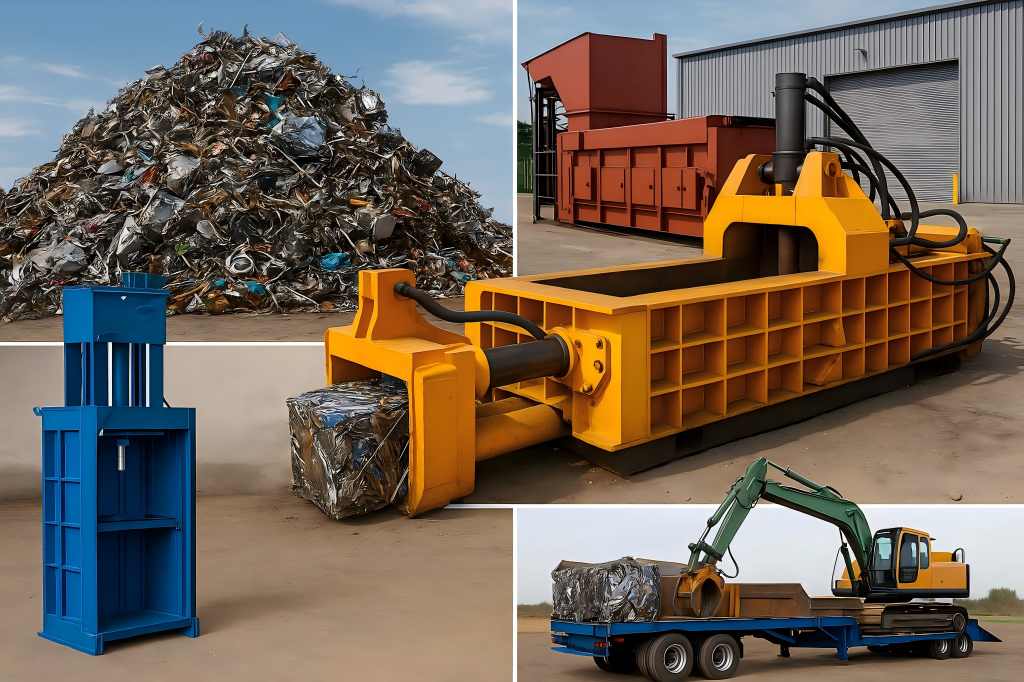Recycling requires scrap metal balers, which compress materials like steel, copper, and aluminum into small bales for storage and transportation. It’s crucial to know what factors influence the price when purchasing one, though, as it goes beyond simply choosing a model.
This article explains the main factors that drive baler costs to help buyers make smart, budget-friendly decisions.
Types of Scrap Metal Balers
Before exploring price drivers, it’s essential to understand the common types of balers, each designed for different processing requirements:
| Baler Type | Use Case | Typical Price Range |
| Vertical (Downstroke) | Light-duty, low volume | $10,000 – $50,000 |
| Horizontal (Manual/Semi) | Mid-sized operations, increased automation | $30,000 – $200,000 |
| Fully Automatic Balers | High-volume, industrial-scale recycling | $150,000 – $500,000+ |
| Two-Ram Balers | Multi-material, high-density baling | $200,000 – $600,000+ |
| Mobile Scrap Balers | On-site or remote processing | $100,000 – $400,000 |
Each of these categories comes with varying levels of baling force, throughput, and automation—key elements that influence price.
Base Machine Price Ranges
The base price of a scrap metal baler generally includes:
- The baling press frame
- Hydraulic system
- Control panel (manual or PLC-based)
- Loading door (or hopper)
- Ejection system
Price Brackets
- Entry-level machines (manual vertical balers): ~$10,000–$25,000
- Mid-range horizontal balers: ~$60,000–$150,000
- Advanced fully automatic or two-ram balers: ~$200,000–$600,000+
These estimates vary by brand, capacity, configuration, and country of origin.
Key Cost Drivers
Now, let’s unpack the most important factors that influence the price of a scrap metal baler.
Baling Force & Capacity
One of the primary price determinants is baling force—measured in tons.
| Baling Force | Suitable Materials | Cost Impact |
| <50 tons | Aluminum cans, foil | Low |
| 50–150 tons | Steel sheets, pipes | Medium |
| 150–300+ tons | Car bodies, heavy scrap | High |
Higher force enables denser bales, but requires heavier structural components and more powerful hydraulics—pushing up the price.
Automation Level
Automation reduces labor needs and improves throughput:
| Automation Level | Features | Price Impact |
| Manual | Lever/push-button controls | Low |
| Semi-Automatic | Sensors, automated compression | Medium |
| Fully Automatic | PLCs, auto-tie, continuous feed | High |
PLC-based systems with HMI interfaces significantly increase machine cost, especially when paired with conveyors or robotic feeding systems.
Build Quality & Materials
Heavy-duty frames, stainless steel panels, and reinforced welds contribute to machine durability but also raise the cost. Equipment made with:
- High-tensile steel → boosts strength, costs more
- Imported parts (e.g., Siemens PLC) → increases price but enhances performance
Brand reputation and country of origin can further influence cost due to labor, regulation, and quality standards.
Power Systems
Electric vs diesel power impacts both upfront and running costs:
| Power Type | Common In | Cost Notes |
| Electric | Stationary plants | Lower running cost, cleaner operation |
| Diesel | Mobile/remote units | Higher purchase price, more maintenance |
Hydraulic pump power ratings also affect pricing—more power means faster cycle times but requires larger motors and oil reservoirs.
Mobility Features
Mobile balers cost more due to additional engineering and ruggedization.
- Trailer-mounted or track-mounted frames
- Hydraulic legs, integrated cranes, or auto-loading arms
- Reinforced chassis for off-road use
These features add $50,000–$200,000 to the base price, depending on configuration.
Optional Features & Customization
Manufacturers often offer a range of add-ons that can tailor a baler to specific needs:
| Feature | Cost Estimate |
| Conveyor feed system | $10,000 – $50,000 |
| Auto-tie mechanism | $15,000 – $40,000 |
| Bale wrapping unit | $5,000 – $20,000 |
| Remote monitoring (IoT) | $2,000 – $15,000 |
| Soundproofing & insulation | $1,000 – $5,000 |
| Safety upgrades (light curtains, E-stop zones) | $2,000 – $10,000 |
Each option improves productivity, safety, or regulatory compliance—but at a cost.
Operating Expenses and Total Ownership
Costs: One component of the puzzle is the purchasing price. Buyers who are astute take into account the total cost of ownership (TCO), which comprises:
Use of Energy
The daily draw of high-capacity balers ranges from 50 to 200 kWh. Power bills are decreased by efficient motors.
Maintenance & Spare Parts
Regular oil changes, seal replacements, and sensor calibrations are required. Some OEMs have expensive proprietary parts.
Labor Costs
Manual balers require more human input, while automatic models reduce labor but demand skilled operators.
Downtime Risks
Cheap machines may lead to more frequent breakdowns—costing valuable production hours.
Market Trends Influencing Baler Prices
Several external forces impact the cost of scrap balers globally:
| Trend | Effect on Price |
| Steel price volatility | Affects manufacturing cost |
| Global supply chain disruptions | Raises shipping and component prices |
| Environmental regulations | Demand for energy-efficient upgrades |
| Labor shortages | Push for automation increases cost |
| Digital transformation (IoT, AI) | Smart tech adds upfront cost |
Especially after COVID-19, many manufacturers reported 10–25% price increases due to raw material shortages and logistic delays.
How to Evaluate ROI
When calculating Return on Investment (ROI), consider:
- Daily throughput (tons per hour)
- Bale density (more density = fewer transport trips)
- Labor savings
- Scrap resale value increases (better-compacted bales = better pricing)
Example ROI Calculation
| Metric | Value |
| Baler cost | $150,000 |
| Operating days/year | 250 |
| Labor saved per day | $200 |
| Scrap value increase/day | $150 |
| Annual savings | $87,500 |
| Payback period | 1.7 years |
Machines that pay for themselves in under 3 years are typically considered good investments.

Real-World Price Examples
Example 1: Vertical Baler
Model: Manual 50-ton baler
Application: Aluminum cans
Price: ~$18,000
Key Features: Manual tie, single-phase electric, no conveyor
Example 2: Horizontal Semi-Automatic Baler
Model: 150-ton horizontal
Application: Mixed light scrap
Price: ~$120,000
Key Features: Auto compress, manual tie, conveyor feed
Example 3: Two-Ram Fully Automatic Baler
Model: 250-ton two-ram
Application: High-density bales for export
Price: ~$380,000
Key Features: PLC, continuous feed, auto-tie, IoT monitoring
Example 4: Mobile Scrap Baler
Model: Diesel-powered trailer baler
Application: On-site vehicle scrapping
Price: ~$310,000
Key Features: Hydraulic crane, trailer chassis, remote operation




